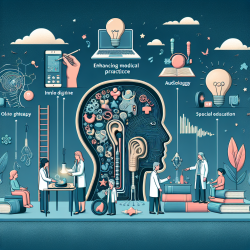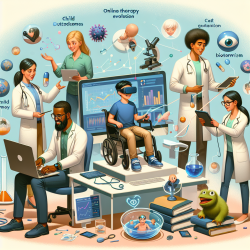Introduction
In the rapidly evolving field of speech-language pathology, the integration of technology such as artificial intelligence (AI) is proving to be a game-changer. A recent study titled KBG syndrome: videoconferencing and use of artificial intelligence driven facial phenotyping in 25 new patients offers valuable insights into how AI can aid in diagnosing rare genetic disorders like KBG syndrome. This blog will explore how practitioners can leverage these findings to enhance their diagnostic skills and improve outcomes for children with developmental disorders.
Understanding KBG Syndrome
KBG syndrome is a rare genetic disorder characterized by craniofacial, intellectual, and neurobehavioral anomalies. It is caused by variants in the ANKRD11 gene and deletions in 16q24.3. Common traits include short stature, macrodontia, and specific facial features such as thick eyebrows and a wide nasal bridge. Behavioral issues and developmental delays are also prevalent, with a significant percentage of individuals diagnosed with autism spectrum disorder and attention deficit hyperactivity disorder.
The Role of AI in Diagnosis
The study highlights the use of AI-driven facial phenotyping tools like GestaltMatcher and DeepGestalt, which analyze facial photographs to identify syndromic features. These tools can significantly enhance the diagnostic process by providing a 'gestalt score' that indicates the similarity of a patient's facial features to those associated with specific genetic disorders.
- GestaltMatcher: This tool quantifies the similarity in features between patients with KBG syndrome, allowing for the identification of syndrome-specific traits.
- DeepGestalt: It ranks potential syndromes based on facial morphology, offering a list of the top 30 syndromes that match the patient's features.
Implications for Practitioners
For practitioners, integrating AI into the diagnostic process can lead to earlier and more accurate diagnoses. This is crucial for conditions like KBG syndrome, where early intervention can significantly impact developmental outcomes. Here are some practical steps practitioners can take:
- Incorporate AI Tools: Utilize AI-driven facial recognition software as part of the diagnostic toolkit. This can help in identifying subtle dysmorphic features that might be missed during a traditional examination.
- Embrace Telehealth: The study demonstrated the effectiveness of videoconferencing in conducting assessments. This approach can increase access to specialized care, especially for families in remote areas.
- Collaborate and Share Data: Engage in data sharing with international registries to enhance the understanding of rare disorders and improve diagnostic accuracy.
Encouraging Further Research
The integration of AI in diagnosing KBG syndrome is just the beginning. Practitioners are encouraged to participate in ongoing research and contribute to expanding the knowledge base. By doing so, they can help refine AI algorithms, making them more effective in identifying a broader range of genetic disorders.
Conclusion
AI-driven facial phenotyping represents a significant advancement in the field of speech-language pathology. By embracing these technologies, practitioners can improve diagnostic accuracy, leading to better outcomes for children with developmental disorders. As we continue to explore the potential of AI, the future of diagnosing and treating rare genetic disorders looks promising.
To read the original research paper, please follow this link: KBG syndrome: videoconferencing and use of artificial intelligence driven facial phenotyping in 25 new patients.










